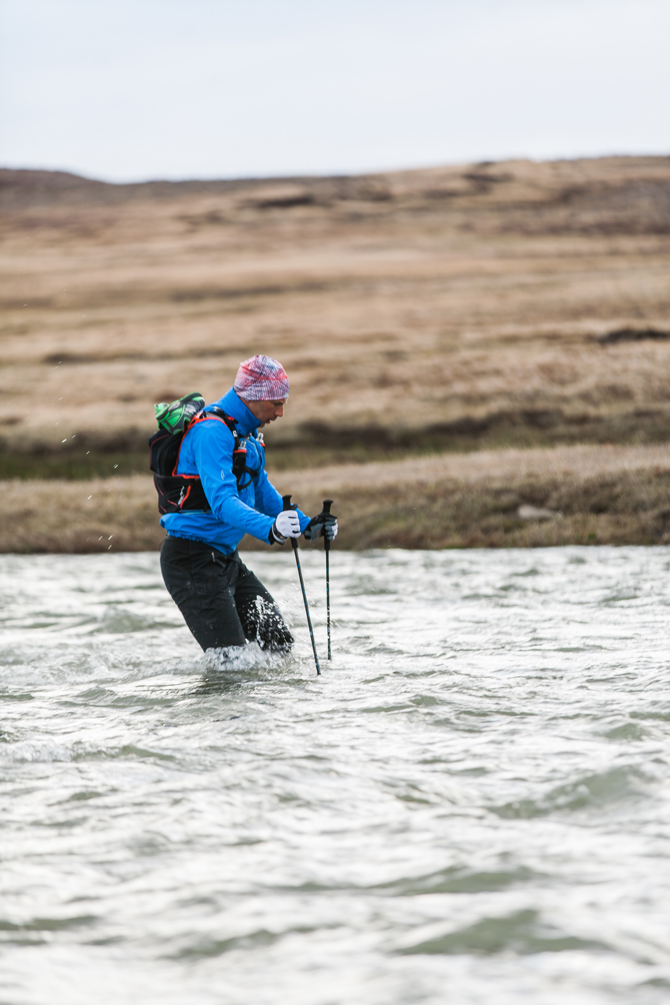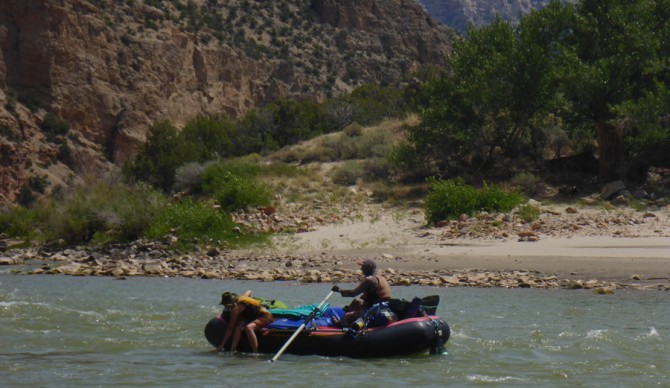Editor’s Note: This is part of the Adventuring Through an Evolving World series, through which members of the Energy and Resources Group at UC Berkeley, in collaboration with Adventurers and Scientists for Conservation, will lend a quantitative eye to environmental change and its relationship to the outdoor sports community.

Even pristine waterways and sparsely populated coastal waters contain microplastics. ASC adventurer Pavel Cenkl captured this photo on Húnafjörður on Iceland´s north coast during his Climate Run. This clean shot of the Arctic Ocean offers a sharp contrast to the Atlantic Ocean off of the islands southern coast. Cenkl noted that this water was littered with debris from fishing boats and abandoned shipwrecks. Samples that Cenkl took from both oceans are currently being analyzed for microplastics concentration. Photo: Pavel Cenkl
Our adventures outdoors are inherently selfish pursuits. We take advantage of our environment for these undertakings, but what external benefits arise from a hike in the woods, a paddle down the river, or an impressive first ascent? How do our endeavors help fortify the natural resources on which they rely?
I know I’m not the only one who struggles with this aspect of the sports we love. And I also know there’s no shortage of support for pro-environmental policy and action within the outdoor community. Yet too often, nebulous “support” is where this road ends. There’s no denying that the demographic distribution of this community is one that tilts toward privilege, education, and a modicum of financial stability. The truth behind the “climber living in his or her van” image is that they are almost always choosing that lifestyle for personal happiness and fulfillment. There’s absolutely nothing wrong with this choice, but the option to pursue a lifestyle connected strongly to the natural world is a resource often available only to those with the proper means. If you have the time to spend your weekends rock climbing, it’s not enough to lament local habitat destruction while topping out a route in the Valley. You have an obligation to work toward the health of the environmental systems that provide for your activities.
Encouraging the translation of outdoor enthusiasts’ “conservation ethic” to meaningful action is where Adventurers and Scientists for Conservation comes in. It facilitates the inherent connection between sustainable environmental practices and the community of adventurers who depend on that environment’s longevity, engaging these adventurers in research projects aimed at understanding processes contributing to environmental change. The projects range from monitoring wildlife on the grasslands of the American Prairie Reserve to gathering ice samples from high altitude glaciers — the project through which I was first introduced to the organization. One of ASC’s most successful endeavors thus far has been the mapping of aquatic microplastics.

This map shows the location of water samples collected as part of ASC’s microplastics research. The size of the circle indicates the concentration of microplastics found in the sample. Image: adventurescience.org
Microplastics are, as the name suggests, tiny bits of plastic that enter streams, lakes, and oceans via several sources. One such source that has received a good deal of media attention are the “microbeads” used in many cosmetic products. These beads make their way down our drains but are too small to be filtered in wastewater plants and are thus carried out into natural waterways. Another source is perhaps less familiar but particularly relevant to outdoors enthusiasts: synthetic fibers released from clothing in the wash. That’s right, each time you wash your favorite fleece sweater after a backpacking trip, you could be releasing close to 2,000 of these pollutants.
The impacts of microplastics remain an active area of research, yet it’s believed that the greatest danger is the propensity of toxins like DDT and BPA to adhere to them. Like mercury in large fish, these toxins accumulate in greater concentrations as you move up the food chain, leading to both environmental and human health hazards. For more info, see this extensive 2008 report from UNESCO.

Microplastic fibers from a marine water sample, as seen under magnification. Image: Wikipedia Commons
So what are ASC adventurers doing to help this issue? “It’s a two-pronged approach,” says Microplastics Principal Investigator Abby Barrows.
The first involves the technical research. To design effective policy aimed at mitigating the dangers of microplastics we need a precise understanding of the problem — where the pollution is coming from and where it’s going. ASC, with its access to athletes and adventurers traveling throughout the world’s rivers, lakes, and oceans, is uniquely positioned to address this question. “I want to publish this data in an accessible fashion so that we can leverage local, national, and international efforts,” says Barrows. “We’re getting data from such interesting and remote areas, and it’s highlighting how much of a global issue this is.”
These adventure scientists have taken ocean samples across the Pacific and the Atlantic at varying depths and along the coasts of several continents and islands, uncovering patterns of microplastics concentrations and identifying the distribution of plastic particles that provide crucial information on the sources of pollution at a given location. “I’m so thankful that these [adventurers] are willing to maintain scientific rigor when they are out enjoying themselves,” says Barrows, who hadn’t even considered the possibility of a global scope to her microplastics research until she discovered the ASC network.
The second impact is the creation of a path for information and action to flow through to the public. “So much of science doesn’t have a way to feed into lay communication,” remarks Barrows, “and that’s something I’ve tried to avoid in this project.” Indeed, the folks collecting microplastics samples are not your archetypal lab coat-wearing, pocket calculator-toting researchers. The beauty of the program is that these roles are filled by athletes and adventurers who have a desire (obligation?) to contribute to the protection of our environment. Communication of their interest and work on the project spreads through their own social and professional channels, reaching far further into the public eye than would a handful of scientific publications.

ASC athlete Jessica Kilroy collected one set of water samples during a five-day rafting trip along the Green River. Photo: Sequoia Haughey
Take Jessica Kilroy. A musician and rope access technician, in addition to an avid climber, she has always felt the need to give back to the natural world that provides her with fodder for her adventures, inspiration for her music, and a steady paycheck. She credits her father, a mountaineer and forester, for instilling in her the responsibility to care for these resources. “I hold this kind of thing really close to my heart,” says Kilroy, “because I’m outside all of the time.”
She saw the project as a way to leverage her nomadic lifestyle as she travels across the country and the world for climbing, performances, and rope access jobs: “The scientific side [of the project] is totally fascinating to me, and this way I can be hands-on and contribute.” Becoming familiar with particular areas through her adventures has given her a unique perspective on the change she sees in ecosystems.

ASC athlete Jessica Kilroy enjoys a quiet moment after collecting water samples from the Yuba River in California. Photo: Sequoia Haughey
“A river is like an organism and changes when it becomes sick,” she explains. “If you don’t know a person and they are sick, you might not notice… but if you know them, you can see it happening. If you pay attention, you will notice when a river is unhealthy, just like a person.”
This perception of change in the ecosystems she frequents is what drew her to the microplastics project and is one reason she is carrying the message through to the music community. Her latest project incorporates soundscapes of rivers into her songs, and she hopes to use the accompanying tour as a platform to discuss the impacts of microplastics in our waterways. In addition to donating the proceeds from the music to ASC’s project, she hopes that these conversations will encourage people to actively reduce their microplastics pollution and think of other ways to minimize their environmental footprint.

Pavel Cenkl encountered a variety of trail conditions on his Climate Run, including “wet”. Photo: Jill Fineis
Another ASC athlete, Pavel Cenkl, devotes a significant portion of his life toward communication of climate change and climate resilience matters. After eight years as a professor of environmental humanities at Sterling College, Cenkl wanted a new way to engage the world about climate. “I wanted to share this connection that I’ve been trying to make throughout my whole professional life between athleticism, action, and ecological systems,” says Cenkl.
Out of this desire was born the Climate Run, a 240-kilometer adventure across Iceland designed “to inspire other athletes, adventurers, and outdoor enthusiasts to take the initiative to help preserve the lands that we love to explore and to find solutions to the challenges of climate change.” On this run, he collaborated with ASC to collect microplastics samples from the two very different marine environments of the northern Atlantic and southern Arctic oceans. Similar to Kilroy, experience in the outdoors has shaped Cenkl’s perspective on environmental change and inspired him to action. He partially attributes the concept of the Climate Run to an experience he had several years prior while leading a field course on Iceland.
According to Cenkl, “I was able to get away from the group for a couple of hours and hike to the foot of the Skaftafell glacier. The constant, incessant movement of the glacier fascinated me, and I stood there for an hour or two just watching what was happening.” It sometimes takes the microscopic lens that you have when standing next to a massive glacier to see how significant change is affecting large-scale systems that seem static from the 1000-meter viewpoint. Cenkl hopes to use this run to provide that lens for others and inspire them to action.
So, maybe Cenkl and Kilroy’s stories resonate with your inner conservation ethic, or maybe they don’t. Maybe microplastics pollution is old news to you and maybe it’s not. Regardless, the question is this: What can you do about it as an individual? Well, first off, you can limit the plastics that you are contributing to our waterways. Ditch the face scrub or toothpaste with those tiny microbeads and cut back on the number of times you wash your synthetic clothing. I know that vest you live in on backpacking trips gets smelly, but let’s be honest — it’s just going to get smelly again on the next trip. Second, if you’ve always wondered how your adventures could help benefit the environment on which they depend, move beyond conversation and thought and put your conservation ethic to use!
“Without people willing to contribute to projects like this,” notes Barrows, “they just wouldn’t be possible.”
With a database of over 1,000 samples collected, mostly from oceans, ASC is now looking to expand their freshwater efforts. On your next paddling, fishing, or hiking trip, consider taking part in this novel, crowdsourced environmental research by collecting samples to be analyzed for plastics concentrations. You never know, it could change the way we tackle this growing environmental and human health hazard.

Participants in the Adventurers and Scientists for Conservation Microplastics project contribute to the understanding of microplastics pollution by collecting samples from freshwater and marine habitats around the world. Photo: Sam Kulla
For more information on the people and organizations behind Adventures Through an Evolving World, be sure to check out the Energy & Resources Group at UC Berkley as well as Adventurers and Scientists for Conservation.
Catch up with the rest of the series:
Adventuring Through an Evolving World: A Series on Environmental Change

